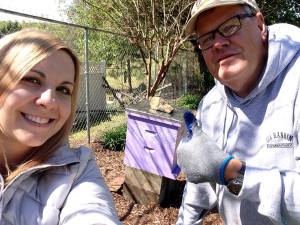Lesson 15 – The Art of Essential Recored Keeping

The instructor, Mr. G, steps in and gives her a thumbs up with her newly set hive in the background.
As a beekeeper, you will find it extremely difficult to keep detailed records for several reasons. First, if you have lots of hives, it will seems like it requires too much time. You’re too busy keeping your smoker going, working on your colonies and trying not to get stung to keep records. Secondly, you think you can make a mental note to jot down when you get back to the kitchen table for lunch. It will not likely happen.
When I started beekeeping, I kept “mental notes” on my hives which was really no notes at all. “Now which one was queenless…was it this one?” Once I started keeping detailed records, I begin to be a better beekeeper. I began to have greater success, less problems and greater honey production. Record keeping will improve your operations.
I gave you a little yellow notebook to get you started, but there are many ways you can keep records. The cheapest way is to buy a spiral notebook and take it to the field with you and write a summary after you inspect each hive. Sometimes it’s quick and simple: “C5 – Eggs & good brood.”
You can keep records in a 3-ring note book. I like this one a lot because it gives me more room. I can take it in the field with me, and as you can see in the picture, I even paste in digital photos into the note book.
My current favorite way is the use of technology…my iphone. I take a photo or two of each hive, which helps me to identify the hive. I have a notes page set up on each hive, can dictate on the page my findings, and then copy and paste my photos. I also find that video works well, especially if I am seeing some problems I may want to ask another bookkeeper about. This works really well because video speak a thousand times more than words. With video logging, you can not only video the hive but of course you can narrate into the video what you see. I think next year I am going to use video notes exclusively for my record keeping and simply download movies into a 2016-2017 file. The videos will automatically save in order of date taken. Easy-Peasy. Remember, you don’t need technology. Just a pad of paper and a pencil works just fine too.
I wonder what I would find if I asked each of you to show me your logs right now? Now here is your wake-up call. Decide now how you plan to keep records on your hive.
I have found that each hive should be assigned some sort of identification marking. I have decided to use my handy dandy label maker left over from my teaching days at school. These labels are plastic and durable….and can easily peel off when I change hives.
Now I cannot stress enough how important it is that you keep a good log with as much detail as you can. This will be very useful in determining why a hive is doing well or perhaps why one died.
Here are a few observations you should make in your log about each hive when inspected:
1) Brood pattern. This will tell you the quality of the queen’s laying ability. Very spotty brood reflects a poor queen. There will always be some spots on the brood, but here’s what you are striving for.
lesson1011
2) General population. Is it expanding as expected?
3) Do you have a queen? Can you spot her or can you see one to three day old eggs in the bottom of cells?
4) Do you have too much bullet brood? Bullet brood is another word for drone brood. It sticks up higher than worker brood and looks a bit like a small bullet. Too much might mean you have a laying worker and the queen is gone.
5) Disease? Rule out American Foul Brood, mite infestation, chalk brood or any other observable problem.
So a log entry might read as follows: “3-4-08 I inspected D-18 and did not spot the queen, but I did see eggs. Brood pattern was good. Good population of bees. No noticeable abnormalities. Need to add a super in about 1 week.”
Always keep track of when you started each hive, where you obtained your bees and/or queen. Keep track of how old your queen is.
As we approach the start to the 2017beekeeping season (which actually begins in the fall), Iwill continue to publish lessons pertaining to the various aspects relating to the beekeeping season. Please review previous lessons.
Remember, BEE-have yourself!
Scott Griffin – Instructor for Mount Holly Bee Apiary